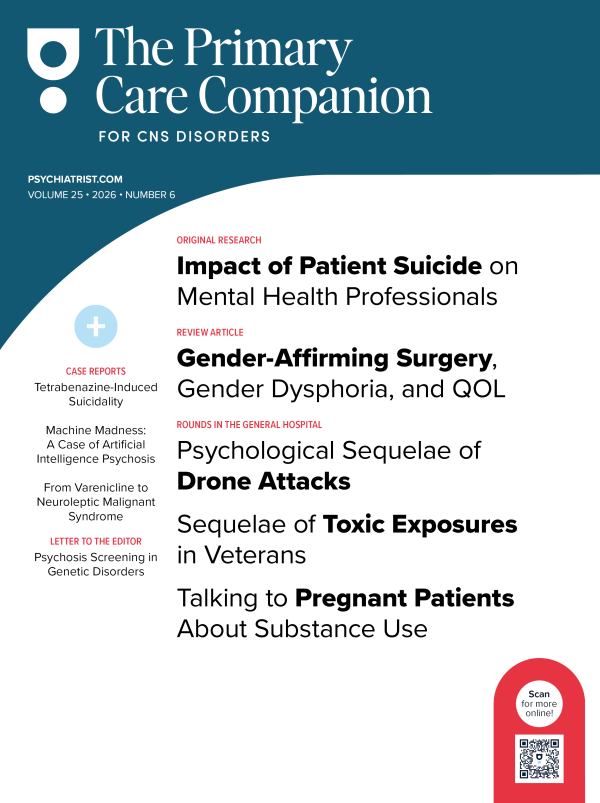Prolactin—A Biomarker for Antipsychotic Treatment Response?
To the Editor: Antipsychotic-induced hyperprolactinemia, due to blockade of D2 receptors in the tubulo-infundibular dopaminergic pathway,1 has been examined predominantly from the perspectives of adverse effects.2 Interestingly, the “neuroleptic threshold” construct conceptualizes the D2/3 occupancy to underlie the clinical efficacy of antipsychotics.3 Antipsychotic-induced hyperprolactinemia, being a proxy indicator of D2 receptor occupancy of antipsychotics, is reported to be associated with clinical improvement in a short-term study.4 Intriguingly, prolactin has even been hypothesized to mediate the adaptive effects of antipsychotics.5 In this report, we describe association between hyperprolactinemia and clinical improvement during a 5-month treatment period.
Method. Clinical records of 10 patients with DSM-IV schizophrenia (mean ± SD age = 29.3 ± 6.5 years; 9 women) attending the Metabolic Clinic in Psychiatry at the National Insitute of Mental Health & Neurosciences (Bangalore, India) from 2008 to 2010 were examined in this study. Four of the patients were on monotherapy with risperidone, 3 were on combination treatment with risperidone and another antipsychotic (1 each with amisulpride, quetiapine, and chlorpromazine), 2 were on treatment with olanzapine alone, and 1 was on combination treatment with olanzapine and amisulpride. Baseline data were taken from the time of registration, and follow-up data were from their most recent visit. Pearson correlation test was applied between baseline serum prolactin level and follow-up Clinical Global Impressions-Improvement scale (CGI-I)6 score and between baseline prolactin level and antipsychotic dose (chlorpromazine equivalent).7,8
Results. There was a significant negative correlation between baseline serum prolactin level (mean ± SD = 102.0 ± 51.6 ng/mL) and CGI-I score (mean ± SD = 1.5 ± 0.5) at follow-up (P = .016; r = −0.731), ie, the higher the prolactin level, the lower the CGI-I score, indicating those who had a higher prolactin level at baseline had better improvement at follow-up. Serum prolactin level did not correlate significantly with the baseline antipsychotic dose (mean ± SD = 302.7 ± 78.5 mg/d) (P = .609; r = −0.185). There was no significant difference between the antipsychotic dose at baseline (302.7 ± 78.5 mg/d) and that at follow-up (267.8 ± 127.3 mg/d) (P = .468).
Our findings lend further support to the possible association between serum prolactin level and clinical improvement with antipsychotics. Our findings are in accord with an earlier short-term study reporting association between hyperprolactinemia and clinical improvement.4 Findings of our study can have potential clinical implication as prolactin elevation could serve as a proxy indicator of D2 receptor occupancy—the mechanism of action of antipsychotics.3 Prolactin elevation is seen to occur rapidly after just a single parenteral or oral dose of antipsychotic.9 Hence, it can be used to predict treatment response even before clinical improvement with an antipsychotic happens and may, thus, help in formulation of individualized therapy.
Though our sample size is modest, this observation is valuable, especially in the context of the paucity of similar studies. Retrospective design might also be considered a limitation; however, this method avoided the rater bias on CGI assessment. In summary, this report suggests a potential role for prolactin to be used as a biomarker for treatment response in schizophrenia, warranting further systematic evaluation.
References
1. Fitzgerald P, Dinan TG. Prolactin and dopamine: what is the connection? a review article. J Psychopharmacol. 2008;22(suppl):12-19. PubMed doi:10.1177/0269216307087148
2. Haddad PM, Wieck A. Antipsychotic-induced hyperprolactinaemia: mechanisms, clinical features and management. Drugs. 2004;64(20):2291-2314. PubMed doi:10.2165/00003495-200464200-00003
3. Howes OD, Egerton A, Allan V, et al. Mechanisms underlying psychosis and antipsychotic treatment response in schizophrenia: insights from PET and SPECT imaging. Curr Pharm Des. 2009;15(22):2550-2559. PubMed doi:10.2174/138161209788957528
4. Otani K, Kondo T, Kaneko S, et al. Correlation between prolactin response and therapeutic effects of zotepine in schizophrenic patients. Int Clin Psychopharmacol. 1994;9(4):287-289. PubMed doi:10.1097/00004850-199400940-00008
5. Moises HW, Zoega T, Gottesman II. The glial growth factors deficiency and synaptic destabilization hypothesis of schizophrenia. BMC Psychiatry. 2002;2(1):8. PubMed doi:10.1186/1471-244X-2-8
6. National Institute of Mental Health. Clinical Global Impressions (CGI) scale. Psychopharmacol Bull. 1985;21:839-843.
7. Rey MJ, Schulz P, Costa C, et al. Guidelines for the dosage of neuroleptics, 1: chlorpromazine equivalents of orally administered neuroleptics. Int Clin Psychopharmacol. 1989;4(2):95-104. PubMed doi:10.1097/00004850-198904000-00001
8. Woods SW. Chlorpromazine equivalent doses for the newer atypical antipsychotics. J Clin Psychiatry. 2003;64(6):663-667. PubMed doi:10.4088/JCP.v64n0607
9. Goodnick PJ, Rodriguez L, Santana O. Antipsychotics: impact on prolactin levels. Expert Opin Pharmacother. 2002;3(10):1381-1391. PubMed doi:10.1517/14656566.3.10.1381
Author affiliations: Department of Psychiatry, The Metabolic Clinic in Psychiatry, National Institute of Mental Health & Neurosciences (NIMHANS), Bangalore, India.
Potential conflicts of interest: None reported.
Funding/support: None reported.
Previous presentation: International Conference on Schizophrenia; October 22-24, 2010; Chennai, India.
Published online: August 25, 2011 (doi:10.4088/PCC.11l01155).
Prim Care Companion CNS Disord 2011;13(4):doi:10.4088/PCC.11l01155
© Copyright 2011 Physicians Postgraduate Press, Inc.


